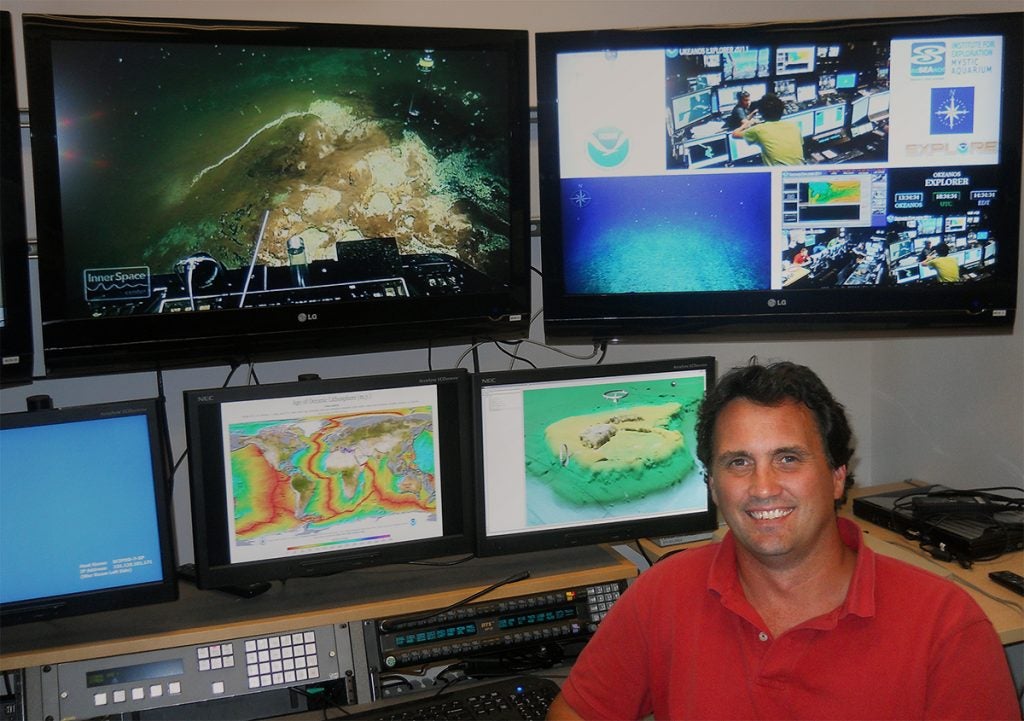
GSO’s Inner Space Center won high praise from federal investigators today for its help finding the data recorder of the doomed El Faro cargo ship.
The National Transportation Safety Board released a transcript of audio recordings from the data recorder, which the center helped locate in 15,000 feet of water off the Bahamas in the Caribbean last spring.
During a news conference this morning in Washington D.C., Christopher Hart, chairman of the NTSB, singled out the Inner Space Center, part of the Graduate School of Oceanography, for its “invaluable assistance’’ in the search.
He thanked the center—the only one of its kind in the country—for installing cutting-edge telepresence technology on the research vessel Atlantis, the Office of Naval Research ship that conducted the search.
The center, Hart said, provided “secure, high-speed, high-volume video and data transmission from the sea floor to the Atlantis and then via satellite to NTSB headquarters for analysis while the mission was in progress.’’
Dwight F. Coleman, center director, said he was honored to work on such an important investigation to assist in “bringing closure to the families who lost loved ones.’’ Last April, Coleman and his staff installed ship-to-shore telecommunications equipment on the Atlantis that linked to NTSB headquarters in Washington, D.C.
He supervised improvements to the ship’s satellite-tracking antenna to allow video and data to stream ashore from the autonomous and remotely operated underwater vehicles used in the search. He also installed telecommunications equipment at NTSB’s headquarters to receive the broadcasts and enable two-way communication.
“We hope to work closely with the NTSB during future investigations that involve any kind of maritime loss, including plane accidents,’’ said Coleman. “Our expertise can be crucial to these types of probes, especially when you’re fighting against time.’’
The 790-foot El Faro, loaded with shipping containers and cars, sank Oct. 1 during Hurricane Joaquin, a Category 4 storm, on its way from Jacksonville, Fla., to San Juan Puerto Rico. All 33 crew members—28 Americans and five Polish nationals—died.
Investigators found the ship a month later. With the help of URI and other organizations, investigators discovered the data recorder in April and retrieved it from the ocean floor in August.
Over the last four months, the NTSB has been examining the recordings to determine what went wrong. One crucial finding is that the captain ordered the crew to abandon ship not long after the main propulsion failed and flooding occurred.
URI is among a notable group of investigators. Other organizations recognized by the NTSB for their assistance are the U.S. Coast Guard; the U.S. Navy Supervisor of Salvage and Diving; the U.S. Navy’s Military Sealift Command; the National Science Foundation; and the Woods Hole Oceanographic Institution.
The Inner Space Center was developed through the efforts of marine explorer and URI Professor Robert Ballard. Supported in part by a $14 million bond issue approved by Rhode Island voters in 2004, the facility opened in 2010.
The center’s mission is to expand participation in seagoing oceanographic research in real time by connecting scientists on ships with their colleagues on shore. It’s modeled after Mission Control at the Johnson Space Center in Houston.
The center supports the research missions of the R/V Endeavor, a URI research vessel; the exploration vessel Nautilus, Robert Ballard’s research ship; and the Okeanos Explorer, which is based at Quonset Point, R.I., and owned and operated by the National Oceanic and Atmospheric Administration. The center hopes to expand its operation over the next few years.
“The El Faro project enhanced the center’s technical capabilities for ocean exploration,’’ said Coleman. “The more projects we do like this, the better we become at what we do. There’s a great future in the world for the application of telepresence technology.’’
Media Contact
Elizabeth Rau
401-874-2116
Posted on December 13, 2016
